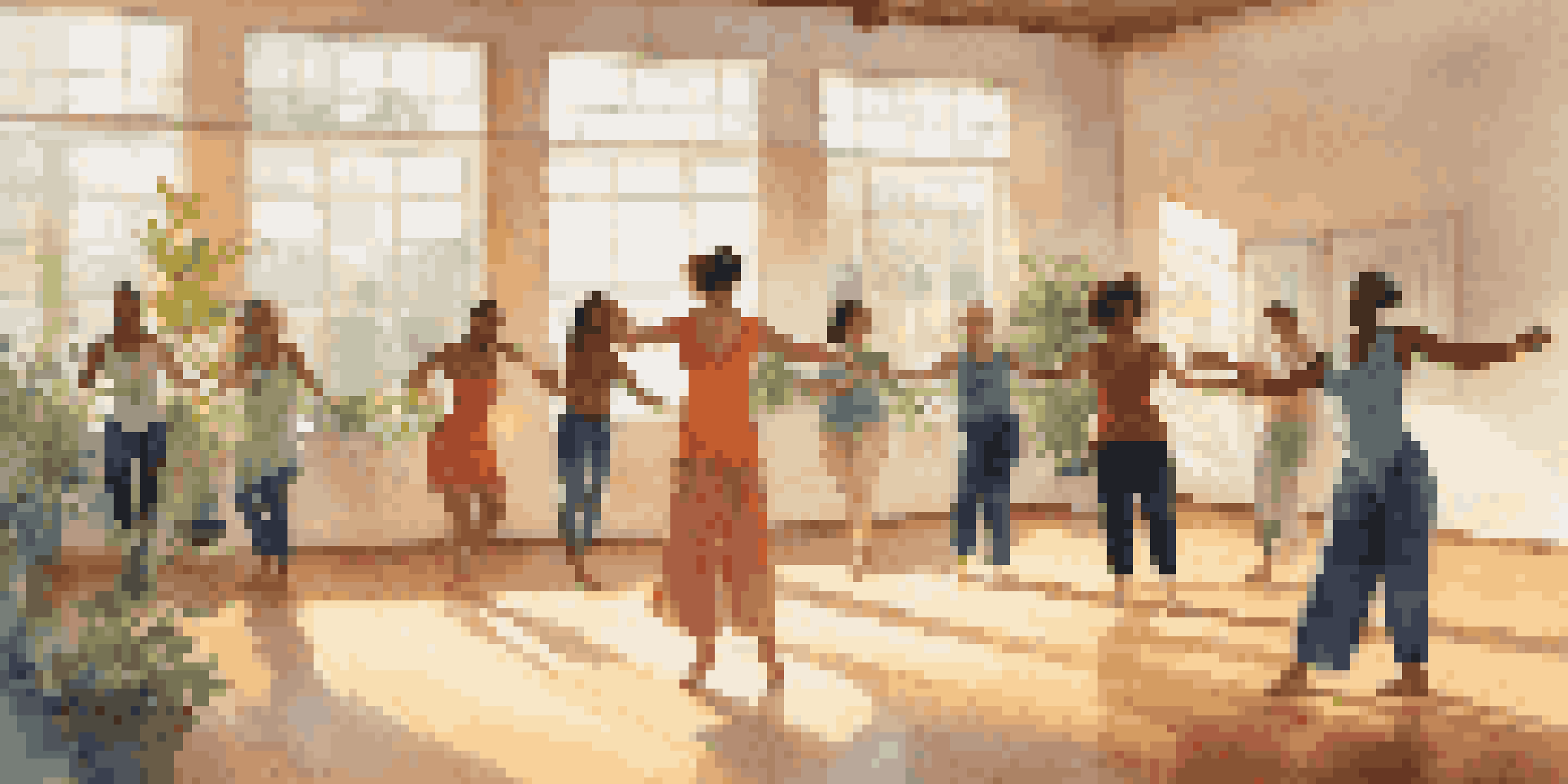Improvisation in Dance Therapy: Healing Through Movement

Understanding Dance Therapy and Its Benefits
Dance therapy is a form of expressive therapy that uses movement to help individuals process emotions and experiences. It's not just about dancing; it's about the healing potential that movement offers. Through dance, participants can explore their feelings in a safe environment, often leading to profound insights about themselves.
Dance is the hidden language of the soul.
One of the key benefits of dance therapy is its ability to reduce stress and anxiety. Movement encourages the release of endorphins, which can elevate mood and foster a sense of well-being. This is especially important in today's fast-paced world, where many individuals feel overwhelmed and disconnected.
Additionally, dance therapy promotes physical health by improving body awareness and encouraging physical fitness. As participants engage in improvisation, they can discover new ways to move, which can enhance their overall physical capabilities while also boosting their confidence.
The Role of Improvisation in Dance Therapy
Improvisation is a crucial component of dance therapy, allowing for spontaneous expression and creativity. Unlike structured dance, improvisation encourages therapists and participants to explore movements that feel natural and authentic to them. This freedom often leads to deeper emotional release and understanding.

When participants engage in improvisational movement, they tap into their instinctual responses, which can reveal emotions that might be hard to articulate verbally. This non-verbal communication can be incredibly healing, as it allows people to express feelings that may have been suppressed or ignored.
Dance Therapy Reduces Stress
Engaging in dance therapy helps lower stress and anxiety levels by encouraging movement that releases endorphins.
Moreover, improvisation fosters a sense of playfulness and exploration. This can be particularly beneficial for individuals who may feel stuck or rigid in their lives. By encouraging spontaneous movement, dance therapy helps participants rediscover joy and creativity.
Building Connection Through Movement
Dance therapy is not just an individual experience; it also emphasizes connection and community. Group sessions allow participants to share their movements and feelings, creating a supportive environment. This shared experience fosters empathy and understanding, as individuals learn from one another's journeys.
The body says what words cannot.
Through improvisation, participants often mirror each other's movements, developing a sense of unity and trust. This mirroring can enhance social skills and improve interpersonal relationships, making it especially beneficial for those who struggle with connection.
The collaborative aspect of improvisation also allows for a rich tapestry of emotions and stories to unfold, creating a collective healing space. This interplay of movements can validate each person's experience, showing them they are not alone in their struggles.
Embracing Vulnerability in Dance Therapy
Improvisation in dance therapy invites participants to embrace vulnerability, which can be a daunting step. When individuals allow themselves to move freely, they expose parts of themselves that may feel raw or unpolished. This act of vulnerability can lead to significant breakthroughs in healing.
As participants explore their movements, they often confront fears and insecurities head-on. This confrontation can be transformative, leading to a deeper understanding of oneself and fostering resilience. By acknowledging their vulnerabilities, individuals can learn to accept and love themselves more fully.
Improvisation Fuels Emotional Healing
Improvisational movement in dance therapy fosters spontaneous expression, allowing participants to explore and release suppressed emotions.
Moreover, the safe space created in dance therapy encourages participants to experiment with their limits. This process of pushing boundaries can enhance emotional strength and cultivate a greater sense of self-worth, ultimately reinforcing the healing journey.
The Science Behind Dance Therapy
Research has shown that dance therapy can have profound psychological and physical benefits. Studies indicate that engaging in dance can decrease symptoms of anxiety and depression while improving overall mood. The physical activity involved in dance releases chemicals in the brain that promote feelings of happiness and relaxation.
Additionally, the act of improvisation stimulates brain areas associated with creativity and emotional regulation. This can lead to improved cognitive functioning and a greater ability to process and express emotions effectively. By integrating movement with emotional exploration, dance therapy taps into the brain's natural ability to heal.
Understanding the science behind dance therapy can help demystify its practices and affirm its legitimacy. As more research emerges, the therapeutic community continues to recognize the value of dance as a tool for mental health and well-being.
Dance Therapy Techniques and Improvisation Exercises
While improvisation is a significant part of dance therapy, there are various techniques and exercises that therapists use to facilitate healing. One common exercise involves guided improvisation, where the therapist provides prompts or themes for movement, allowing participants to interpret the guidance in their own way. This can lead to unexpected discoveries and personal insights.
Another popular technique is the 'body scan,' where participants connect with different parts of their body through movement. This exercise encourages awareness and can help individuals identify areas of tension or discomfort, leading to targeted healing. Combining these techniques with improvisation enhances the therapeutic process.
Connection Through Shared Movement
Group dance therapy sessions create a supportive community, enhancing empathy and interpersonal relationships among participants.
Overall, these exercises aim to create a safe and nurturing environment where participants can explore their movements freely. This blend of structure and spontaneity allows for deeper emotional exploration while maintaining a sense of security.
Finding a Dance Therapist: What to Look For
If you're considering dance therapy, finding the right therapist is crucial for a positive experience. Look for a certified dance/movement therapist who has undergone specialized training. This ensures that they understand the therapeutic process and can create a safe space for exploration.
It's also beneficial to find someone whose approach resonates with you. Every therapist has a unique style, and it's important to feel comfortable and connected with your therapist to reap the full benefits of the process. Don't hesitate to ask about their methods and philosophy during your initial consultation.

Finally, consider the therapist's experience working with specific populations or issues that may relate to your own. Whether it's trauma, anxiety, or physical limitations, finding a therapist who has expertise in your area of concern can enhance your therapeutic journey.